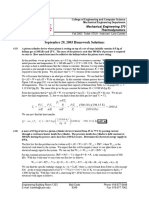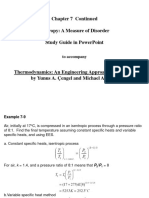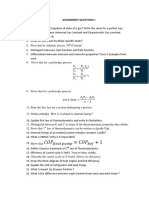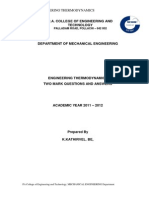Unit Four Homework Solutions, September 23. 2010: Mechanical Engineering 370 Thermodynamics
Unit Four Homework Solutions, September 23. 2010: Mechanical Engineering 370 Thermodynamics
Uploaded by
Rengganis Putri ParmudyaCopyright:
Available Formats
Unit Four Homework Solutions, September 23. 2010: Mechanical Engineering 370 Thermodynamics
Unit Four Homework Solutions, September 23. 2010: Mechanical Engineering 370 Thermodynamics
Uploaded by
Rengganis Putri ParmudyaOriginal Title
Copyright
Available Formats
Share this document
Did you find this document useful?
Is this content inappropriate?
Copyright:
Available Formats
Unit Four Homework Solutions, September 23. 2010: Mechanical Engineering 370 Thermodynamics
Unit Four Homework Solutions, September 23. 2010: Mechanical Engineering 370 Thermodynamics
Uploaded by
Rengganis Putri ParmudyaCopyright:
Available Formats
College of Engineering and Computer Science
Mechanical Engineering Department
Mechanical Engineering 370
Thermodynamics
Fall 2010 Course Number: 14319
Instructor: Larry Caretto
Unit Four Homework Solutions, September 23. 2010
1 A piston-cylinder device whose piston is resting on top of a set of stops
initially contains 0.5 kg of helium gas at 100 kPa and 25 oC. The mass of the
piston is such that 500 kPa of pressure is required to raise it. How much
heat must be added to the helium before the piston starts rising.
In this problem, we are given the helium mass, m = 0.5 kg, which we assume is
constant. We are also given the initial pressure and temperature, P1 = 100 kPa and
T1 = 25oC = 298.15 K. The fact that the piston is resting on stops as heat is added
means that the volume is constant. Because we stop adding heat when the pressure
is just enough to raise the piston, we know that the final pressure, P2 = 500 kPa, the
pressure required to raise the piston. We also know that V 2 = V1 because of the
constant volume process.
We will assume that helium is an ideal gas at these low pressures. We can find the
heat from the first law: Q = U + W = mcvdT + W for an ideal gas. In this constant-
volume process the work, W = 0. From Figure 4-24 on page 177, we see that the heat
capacity of helium is essentially constant over a wide range of temperatures. Thus
we can use the constant heat capacity of helium from Table A-2 on page 909: c v =
3.1156 kJ/(kgK). The same table gives the gas constant for helium; R = 2.0769 kJ/
(kgK).
From the equation that Q = mcvdT + W, we see that Q = mcv(T2 T1) in this case of
constant heat capacity and no work. We do not know the final temperature, T 2, but
we can find it from the ideal gas law (and V2 = V1).
mRT1
P2
P2V2 P2V1 P1 PT (500 kPa )( 298.15 K )
T2 2 1 1490 K
mR mR mR P1 (100 kPa )
We can now find the heat transfer.
3.1156 kJ
Q mcv (T2 T1 ) (0.5 kg ) 1490 K 298.15 K = 1,857 kJ .
kg K
2 A mass of 15 kg of air in a piston-cylinder device is heated from 25 to 77 oC
by passing current through a resistance heater inside the cylinder. The
pressure inside the cylinder is held constant at 300 kPa during the process
and a heat loss of 60 kJ occurs. Determine the electrical energy supply in
kWh.
The first law for this problem can be written as Q = U + W = U + We,out + PdV,
where We,out is the electrical work done by the system. We expect that this will be
negative since we see tghat there is an electrical energy input to the system. We can
say that We,in = -We,out = U + PdV Q.
Jacaranda (Engineering) 3519 Mail Code Phone: 818.677.6448
E-mail: lcaretto@csun.edu 8348 Fax: 818.677.7062
For this constant pressure process, PdV = P1-2 (V2 V1) where P1-2 = P1 = P2 is the
constant pressure of 300 kPa. With this work term we can write our first law as
follows.
We,in = U + P1-2 (V2 V1) Q = U2 U1 + P2V2 P1V1 Q = H2 H1 Q = m(h2 h1) Q
We can find the specific enthalpy change, h2 h1 = cpdT, where cp can be found from
Table A-2(b) on page 910. At the average temperature of (25oC + 77oC)/2 = 51oC =
324.15 K, we can interpolate to find cp = 1.0065 kJ/(kgK). With this value of cp (and
using Q = 60 kJ because it is a heat loss) we can find the electrical work input as
follows.
We,in h2 h1 Q mc p (T2 T1 ) Q
1.0065 kJ 1 kWh
(15 kg ) 350.15 K 298.15 K ( 60 kJ )
kg K 3600 kJ
We,in = 0.235 kWh .
3 A room is heated by a baseboard resistance heater. When the heat losses
from the room on a winter day amount to 6,500 kJ/h, the air temperature in
the room remains constant, even though the heater operates continuously.
Determine the power rating of the heater in kW.
Since the temperature of the air is constant, the internal energy is constant. If we
assume that the volume of the house does not change, there is no work. (Note that
we also have to assume that this is a closed system; i.e. there is no air flow into or
out of the room.) The first law then gives Q =U + W = 0. Thus the heat loss
through the wall is balanced by the heat input from the electric heater. This input
must be 6500 kJ/h = (6500 kJ/h)[(1 kWh) / (3600 kJ) ] = 1.81 kW .
4 A piston-cylinder device contains 3 ft3 of air at 60 psia and 150oF. Heat is
transferred to the air in the amount of 40 Btu as the air expands
isothermally. Determine the amount of boundary work during this process.
From the first law, Q = U + W, with U = mcvdT for ideal gases. We see that U for
this process is zero, since the
temperature is constant. Thus,
we have W = Q = 40 Btu .
5 A piston-cylinder device, with
a set of stops on the top, Problem 4-73
5
initially contains 3 kg of air
at 200 kPa and 27oC. Heat is
now transferred to the air,
and the piston rises until it
hits the stops, at which point
the volume is twice the
initial volume. More heat is
transferred until the
pressure inside the cylinder
also doubles. Determine the
Jacaranda (Engineering) 3519 Mail Code Phone: 818.677.6448
E-mail: lcaretto@csun.edu 8348 Fax: 818.677.7062
work done and the amount of heat transfer for this process. Also, show the
process on a P-v diagram.
From the problem description, we see that the path is a two step path. The first part
is constant pressure as the piston rises to the stops. During this part, the volume
doubles. The second part occurs at constant volume after the piston reaches the
stops. (The actual data points plotted on the diagram are found in the calculations
below.).
If we denote the initial point as P1 = 200 kPa and T1 = 27oC = 300.15 K, and the final
point as P2 = 2 P1 = 400 kPa and V2 = 2 V1, the intermediate point, where the piston
reaches the stops has V = V2 and P = P1. The mass m = 3 kg.
All the work is done during the constant pressure part of the path. This work is
simply found as the rectangular area under the path: W = P 1(V2 V1). The heat
transfer is then found as Q = U + W = mu + P1(V2 V1).
If we assume that air behaves as an ideal gas at these pressures, we can compute
the initial volume from the ideal gas law.
0.2870 kJ
(3 kg ) ( 27 273.15 K )
mRT1 kg K
V1 1.292 m 3
P1 1 kJ
( 200 kPa ) 3
kPa m
Since we are given V2 = 2 V1, we know that V2 = 2.584 m3. We can now find the work
as follows.
W = P1(V2 V1) = (200 kPa)( 2.584 m3 1.292 m3) = 258.4 kPam3 = 258.4 kJ
To compute the change in internal energy, we need the final temperature. We can
find this final temperature from the ideal gas law.
2mRT1
P2
P2V2 P2 ( 2V1 ) P1 2P T 2( 400 kPa )(300.15 K )
T2 2 1 1200.6 K
mR mR mR P1 ( 200 kPa )
For this large temperature difference we should consider the temperature
dependence of the heat capacity. We can use the ideal gas tables for air on pages
934-35. Interpolating in these tables we find the following values for the ideal gas
internal energy:
u1 = u(300.15 K) = 214.18 kJ/kg u2 = u(1200.6 K) = 933.86 kJ/kg
We can now find the heat transfer, Q = U + W = m(u2 u1) + W = (3 kg)( 933.86
kJ/kg 214.18 kJ/kg) + 258.4 kJ. This gives Q = 2,417.5 kJ .
Jacaranda (Engineering) 3519 Mail Code Phone: 818.677.6448
E-mail: lcaretto@csun.edu 8348 Fax: 818.677.7062
You might also like
- Solved - Problems in ThermodynamicsDocument29 pagesSolved - Problems in ThermodynamicsAngelica Joyce Benito100% (7)
- CHE 133 Lab #2Document4 pagesCHE 133 Lab #2Ben Killam100% (1)
- CH 3Document63 pagesCH 3Hoi An Sze100% (7)
- CHME 5101, Fall 2021: Homework Assignment 3 (Due 10/13/21, 11:59 PM US Eastern Time) Problem 1Document4 pagesCHME 5101, Fall 2021: Homework Assignment 3 (Due 10/13/21, 11:59 PM US Eastern Time) Problem 1TosinNo ratings yet
- IB Physics DefinitionsDocument12 pagesIB Physics DefinitionsAdrian Loke0% (1)
- HW 0304Document3 pagesHW 0304Vijandamuje NunuheNo ratings yet
- Tutorial3 s16Document5 pagesTutorial3 s16smart100% (1)
- Unit Nine Homework Solutions, November 9, 2010: V V R T T C S S Const C If V V R T DT C S SDocument5 pagesUnit Nine Homework Solutions, November 9, 2010: V V R T T C S S Const C If V V R T DT C S SAbubakar AdeniNo ratings yet
- Entropy ProbsDocument5 pagesEntropy ProbsFAzle RAbbyNo ratings yet
- Assignment 2 NewDocument7 pagesAssignment 2 NewKartavya AggarwalNo ratings yet
- ChE234 F10 Exam2 Thermodynamics For Chemical EngineersDocument3 pagesChE234 F10 Exam2 Thermodynamics For Chemical EngineerskellykapperNo ratings yet
- THRM1001 Tutorial 4 1st Law of ThermodynamicsDocument2 pagesTHRM1001 Tutorial 4 1st Law of ThermodynamicsDimitri RamloganNo ratings yet
- QB Unit 1Document6 pagesQB Unit 1Gaurav GadhesariaNo ratings yet
- 2nd Law Analysis For A Control VolumeDocument13 pages2nd Law Analysis For A Control VolumeSergey ShkapovNo ratings yet
- Engineering Thermodynamics Solutions ManualDocument46 pagesEngineering Thermodynamics Solutions ManualMidoNo ratings yet
- Thermodynamics (Solved Prob)Document22 pagesThermodynamics (Solved Prob)Jubert Perez100% (1)
- 23mee202et Questionbooklet-2Document7 pages23mee202et Questionbooklet-2rethinagiriswaransheshanthNo ratings yet
- Thermodynamics Worked ExamplesDocument13 pagesThermodynamics Worked ExamplesSalah Salman100% (2)
- ME-1100 Thermodynamics May - June 2022 - Trimester Tutorial - 3Document2 pagesME-1100 Thermodynamics May - June 2022 - Trimester Tutorial - 3Aiswarya Ramesh me21b011No ratings yet
- 23mee202et Questionbooklet-2-1Document9 pages23mee202et Questionbooklet-2-1rethinagiriswaransheshanthNo ratings yet
- Tutorial No: 2 Energy Transfer: Fundamentals of Thermodynamics and Heat TransferDocument3 pagesTutorial No: 2 Energy Transfer: Fundamentals of Thermodynamics and Heat TransferSaroj BaralNo ratings yet
- 2W04 Assignment 4 - 2023 Solutions PDFDocument6 pages2W04 Assignment 4 - 2023 Solutions PDFas asNo ratings yet
- Problems - 4Document1 pageProblems - 4jamesgNo ratings yet
- Thermodynamics Questions and AnswersDocument5 pagesThermodynamics Questions and AnswersMD SHOEBUDDIN0% (1)
- Solution Week 9Document6 pagesSolution Week 9Ariadne ChuaNo ratings yet
- Tutorial 3Document2 pagesTutorial 3kaeshav manivannanNo ratings yet
- Tutorial - 6 - EntropyDocument7 pagesTutorial - 6 - EntropyanotherdeobiNo ratings yet
- Closed System Energy Analysis: Ideal Gases: AssumptionsDocument1 pageClosed System Energy Analysis: Ideal Gases: AssumptionsSAATISHNo ratings yet
- Reviewlecture-I 20081001 48e3c2399f4d65 74115154Document37 pagesReviewlecture-I 20081001 48e3c2399f4d65 74115154Austin BarrilleauxNo ratings yet
- ME 231 Montazami Whharris 10-2-18 Class Work SolutionDocument15 pagesME 231 Montazami Whharris 10-2-18 Class Work SolutionJoana ArielaNo ratings yet
- Solutions ProblemSet8 Sem22007Document7 pagesSolutions ProblemSet8 Sem22007clearcastingNo ratings yet
- TutorialsDocument11 pagesTutorialsAditya MallickNo ratings yet
- HW8 SolutionDocument4 pagesHW8 SolutionchrisNo ratings yet
- Chapter 7 Continued Entropy: A Measure of Disorder Study Guide in PowerpointDocument53 pagesChapter 7 Continued Entropy: A Measure of Disorder Study Guide in Powerpointbrayan CortezNo ratings yet
- 2W04 Assignment 5 - 2023 Solutions PDFDocument4 pages2W04 Assignment 5 - 2023 Solutions PDFas asNo ratings yet
- ES 31 - Thermodynamics and Heat TransferDocument5 pagesES 31 - Thermodynamics and Heat Transferyeng botzNo ratings yet
- Tutorial MED205Document4 pagesTutorial MED205Anonymous V4jDKjUR6No ratings yet
- MMAN2700ThermoProblemSheet7 - Entropy 2nd LawDocument3 pagesMMAN2700ThermoProblemSheet7 - Entropy 2nd Lawgrandw9524No ratings yet
- Engineering Science LGD 10703: Ideal GasDocument7 pagesEngineering Science LGD 10703: Ideal GasazzraNo ratings yet
- Question From MoranDocument12 pagesQuestion From MoranandrewjovellanaNo ratings yet
- Tutorial Sheets For Thermodynamics 02Document3 pagesTutorial Sheets For Thermodynamics 02Aditya raj sachdevNo ratings yet
- Engg ThermodynamicsgfDocument3 pagesEngg Thermodynamicsgfphysics a2No ratings yet
- Thermodyancs Chapter 9 Solution ManuelDocument36 pagesThermodyancs Chapter 9 Solution ManuelFarhad MojaverNo ratings yet
- Moving Boundary Work: 5 KG of Saturated Water Vapor in Cylinder Is Heated at Constant Pressure (300 Kpa)Document8 pagesMoving Boundary Work: 5 KG of Saturated Water Vapor in Cylinder Is Heated at Constant Pressure (300 Kpa)yeng botzNo ratings yet
- Chap4firstlawthermodynamics 130703012634 Phpapp02 141209125348 Conversion Gate02Document61 pagesChap4firstlawthermodynamics 130703012634 Phpapp02 141209125348 Conversion Gate02Abdelkader Faklani DouNo ratings yet
- Mae 320 HW 04 SolDocument7 pagesMae 320 HW 04 SolEvan DurstNo ratings yet
- Applications of First LawDocument12 pagesApplications of First LawHarminder SinghNo ratings yet
- Assignment Sheet 1 PDFDocument4 pagesAssignment Sheet 1 PDFRahul SinghNo ratings yet
- ME3100 Solution Tut-2Document8 pagesME3100 Solution Tut-2B V V HANUMA GAYATHRINo ratings yet
- A Single Acting Compressor Has A Volumetric Efficiency of 87Document2 pagesA Single Acting Compressor Has A Volumetric Efficiency of 87Harley Quinn0% (1)
- Problem Set#1Document2 pagesProblem Set#1ron ronnnNo ratings yet
- TermoDocument14 pagesTermoGagah ArofatNo ratings yet
- First Law of Thermo2Document14 pagesFirst Law of Thermo2ananthiramaraoNo ratings yet
- Chapter 4Document3 pagesChapter 4PowerofHaki100% (4)
- An Air-Standard Cycle Is Executed in A Closed SysDocument1 pageAn Air-Standard Cycle Is Executed in A Closed SysVincent BaguioNo ratings yet
- Tarea 5 TermodinamicaDocument4 pagesTarea 5 TermodinamicaMario GonzalezNo ratings yet
- HW 0225Document8 pagesHW 0225Sures RezNo ratings yet
- Second LawDocument12 pagesSecond Lawcobalt boronNo ratings yet
- Thermo MDocument20 pagesThermo MhussainmohdjakirNo ratings yet
- Thermodynamics: 3251.0 / KJ KG 15 Kpa 15 Kpa 225.94 / KJ KG 2598.3 / KJ KG 10 / KgsDocument68 pagesThermodynamics: 3251.0 / KJ KG 15 Kpa 15 Kpa 225.94 / KJ KG 2598.3 / KJ KG 10 / KgsKumar SahebNo ratings yet
- Chemistry Chapter 3 of FSC Part IDocument69 pagesChemistry Chapter 3 of FSC Part IMuhammad HamzaNo ratings yet
- Unit8 1 TNSDocument11 pagesUnit8 1 TNSSylvesterMcLaneNo ratings yet
- Gases: Lecture PresentationDocument44 pagesGases: Lecture PresentationhaloNo ratings yet
- Student Copy - Caps - 20Document7 pagesStudent Copy - Caps - 20Sujal KumarNo ratings yet
- States of Matter & 6. Thermodynamics11CHEMISTRYDocument4 pagesStates of Matter & 6. Thermodynamics11CHEMISTRYredoxreactionsNo ratings yet
- Arjuna JEE AIR (2024) : KTG & ThermodynamicsDocument13 pagesArjuna JEE AIR (2024) : KTG & Thermodynamicskushmeet0106No ratings yet
- Basic Concepts of Thermodynamics Study Notes For Mechanical EngineeringDocument29 pagesBasic Concepts of Thermodynamics Study Notes For Mechanical EngineeringAshok PradhanNo ratings yet
- B.tech 3rd Sem MechanicalDocument11 pagesB.tech 3rd Sem MechanicalRahul KumarNo ratings yet
- Etd 2mark With AnswerDocument16 pagesEtd 2mark With AnswertagoreboopathyNo ratings yet
- Department Chemistry PG SyllabusDocument40 pagesDepartment Chemistry PG Syllabusrihana yadavNo ratings yet
- CH ETDocument2 pagesCH ETRiddhi ShreeNo ratings yet
- Chapt 4Document33 pagesChapt 4Ahmed AL-HarthiNo ratings yet
- SCH 103 Lecture Notes 2020 Part 1 Dec 11th.Document58 pagesSCH 103 Lecture Notes 2020 Part 1 Dec 11th.Samwel Ochok100% (2)
- Combustion Science and TechnologyDocument26 pagesCombustion Science and TechnologyLinckon HalderNo ratings yet
- NBTS - 02 - B - QPDocument19 pagesNBTS - 02 - B - QPNaman SharmaNo ratings yet
- StatDocument127 pagesStatAhmedAlhosaniNo ratings yet
- Chemistry Honors Study Guide May 2024Document7 pagesChemistry Honors Study Guide May 2024Stan MazoNo ratings yet
- Advanced Problems On Physical Chemistry - 8th Oct.Document22 pagesAdvanced Problems On Physical Chemistry - 8th Oct.Shivam YadavNo ratings yet
- ThermodynamicsDocument9 pagesThermodynamicsJohn Bernard VillarosaNo ratings yet
- Ideal Gas Equation and EntropyDocument27 pagesIdeal Gas Equation and EntropyJude Roswel GenerilloNo ratings yet
- Problem Set (10 Questions) of First-Second Law of ThermodynamicsDocument4 pagesProblem Set (10 Questions) of First-Second Law of Thermodynamicscoolcool2167No ratings yet
- Capítulo 2, TermodinámicaDocument64 pagesCapítulo 2, TermodinámicaISABELLA CUESTAS ACOSTANo ratings yet
- Entropy of Mixing PDFDocument16 pagesEntropy of Mixing PDFrupaliroyNo ratings yet
- ASPEN PLUS (v7.3) (2011-03) - Aspen Physical Property System - Physical Property MethodsDocument245 pagesASPEN PLUS (v7.3) (2011-03) - Aspen Physical Property System - Physical Property Methodsthiarap23No ratings yet
- Lesson 1.2 - Exergy Evaluation On Engineering ProcessesDocument44 pagesLesson 1.2 - Exergy Evaluation On Engineering ProcessesBilly JhunNo ratings yet
- Chemistry ReviewerDocument12 pagesChemistry ReviewerGeromme TudNo ratings yet

























































































